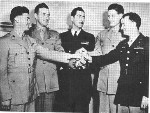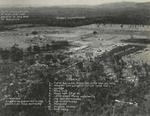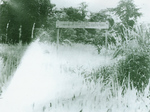The Davao Escape
ww2dbaseGuest Contributor: John D. Lukacs
ww2dbaseOn 7 Nov 1942, 969 American prisoners of war, survivors of the Bataan Death March and the siege of Corregidor, entered the Davao Penal Colony on Mindanao, the southernmost island of the Philippines. Here at "Dapecol," a sprawling, escape-proof, maximum-security prison plantation built in 1932 to house the Philippine Commonwealth's most dangerous criminals, they joined 1,000 fellow Americans who had been captured on Mindanao on 10 May 1942. The Japanese Army intended to use the POWs as slave laborers. But ten of these men had other ideas.
ww2dbaseTheir names were: Navy Lieutenant Commander Melvyn H. McCoy, Army Major Stephen M. Mellnik, Army Air Force pilot Captain William Edwin Dyess and his wingman, Lieutenant Samuel C. Grashio, Army Air Force master mechanic Lieutenant Leo A. Boelens, Marine Corps officers Captain Austin C. Shofner, Lieutenant Jack Hawkins and Lieutenant Michiel Dobervich, and Paul Marshall and Robert Spielman, both Army sergeants from the Coast Artillery. This diverse interservice team would recruit two Filipino convicts who were serving life sentences for murder, a camp hospital orderly with first aid training, Benigno de la Cruz, and his friend, Victor Jumarong. Together, they would execute what would prove to be the only large-scale prison break of Allied prisoners of war in the Pacific War.
ww2dbasePledging their lives to each other, their mission was to break through enemy lines, rejoin American forces in the Pacific and break the news to the world of the Bataan Death March, the deplorable conditions in Japanese prison camps and a litany of atrocities committed against American POWs.
ww2dbaseBut they first had to figure a way out of the barbed-wire stockade that ringed their barracks, then navigate what was believed to be an impassable swamp filled with chest-high water and thick sword grass, 10-foot Philippine crocodiles and swarms of giant insects. Beyond the swamp, the dense surrounding jungles were rumored to be inhabited by tribes of headhunters. It was a daunting task – no Filipino prisoner in the camp's existence had successfully escaped - but the would-be escapees attacked the myriad obstacles in their path to freedom with determination and American ingenuity. They concluded that volunteering for an unsupervised work project on the POWs' only day off, Sunday, would enable them to make their big break and secure valuable time before their absence was discovered. During their daily labors on the camp's vast agricultural parcels, they outwitted guards, measured distances, monitored patrol schedules, stole food and secured gear (such as bolos, Philippine machetes), survey maps and intelligence from sympathetic Filipino civilian camp administrators.
ww2dbaseThe original planned date of the escape was postponed one week due to a surprise inspection that led to the discovery of contraband fruit and vegetables and a mass punishment edict that sent the entire camp to work in the rice paddies on 30 Mar 1943. The escape took place on Sunday, 4 Apr 1943, when the daring "Davao Dozen" retrieved cached supplies and disappeared into the swampy mists. After a harrowing three-day ordeal that climaxed in some extraordinary good fortune and perhaps even divine assistance, they emerged on the other side of history.
ww2dbaseFor weeks the fugitives, aided by Filipino guerrillas and patriots, eluded Japanese search parties, trekked along jungle trails, over rugged mountains and paddled rivers through territory marked "UNEXPLORED" on maps to reach Mindanao's northern coast, where they joined organized guerrilla units resisting the Japanese occupation. Making contact via radio with General Douglas MacArthur's Southwest Pacific Area Theater headquarters in Australia, the first three members of the escape party, Dyess, McCoy and Mellnik, evacuated the island via the submarine USS Trout on 2 Jul 1943. In Brisbane, they briefed U.S. forces on the Death March and horrific conditions inside Japanese prison camps as well as other vital items of military intelligence value. All ten American members of the escape party (with the exception of Lt. Boelens, who was killed by the Japanese on 22 Jan 1944 and received his medal posthumously) were ultimately presented with the Distinguished Service Cross personally by MacArthur. The Filipino convicts received pardons from the Philippine president-in-exile, Manuel Quezon.
ww2dbaseAfter returning to the United States, the escapees were immediately muzzled by President Franklin D. Roosevelt and Washington officialdom (who were fearful that the story of atrocities committed against U.S. military personnel would incite the American people, jeopardizing the Allies' "Europe First" strategic policy and POW relief efforts). Following the tragic death of Lt. Col. Dyess, the defacto spokesman of the escape party and the man whose name would become synonymous with the escape, the revelations of the Death March and Japanese atrocities, in an airplane accident on 22 Dec 1943, the epic story was finally released by the U.S. Government on 28 January 1944, timed and expertly manipulated in order to harness the full fury of America's anger to aid the war effort by coinciding with the Fourth War Loan Drive. The story, promoted by the U.S. War Department as "The Greatest Story of the War in the Pacific," was, as one newspaperman called it, "the biggest bombshell since Pearl Harbor." One major metropolitan paper called "The Dyess Story" the "most important news break of the war."
ww2dbaseThe daring members of the "Davao Dozen," through their epic escape, changed the course of the war. Strategic military operations were altered in the Pacific Theater, while on the home front, news of the Bataan Death March and other atrocities awoke America from a little-known mid-war complacency slumber. The revelations infuriated Americans, slashed absenteeism in war industry, skyrocketed stagnant war bond sales and service enlistment numbers, shamed the Japanese before the global community, galvanized the American public for a greater prosecution of the Pacific war and, most notably, fundamentally altered U.S. Government wartime censorship policies, returning the Constitutionally-protected First Amendment right of a free press to the Fourth Estate.
ww2dbaseSources:
J. Lukacs, Escape From Davao
4-4-43
ww2dbaseAbout the Guest Contributor
ww2dbaseWriter, adventurer, historian and documentary filmmaker John D. Lukacs specializes in one-of-a-kind stories - the unusual, the unprecedented and the virtually unknown.
ww2dbaseHis first book was Escape From Davao: The Forgotten Story of the Most Daring Prison Break of the Pacific War. Lukacs's first documentary film, titled 4-4-43, was an official selection of the 2014 GI Film Festival. He is currently working on books on the Battle for Manila in 1945 and the Aleutians Campaign.
ww2dbaseHis work has appeared in USA Today, The New York Times, World War II Magazine and on ESPN.com. Lukacs has made numerous local and national television and radio appearances, including on ESPN and C-SPAN, as well as Sirius Satellite Radio. A hands-on historian, he has explored World War II battlefields and historic sites throughout both Europe and the Pacific, including: Attu, the Ardennes, Bastogne, Bataan, Hitler's Eagle's Nest at Berchtesgaden, Cabanatuan, Corregidor, Coral Sea, Dachau, Davao, Dutch Harbor, Fiji, Guadalcanal, Guam, Hiroshima, Hong Kong, Iwo Jima, Kiska, Manila, Midway, the Maginot Line, the New Hebrides, Paris, Pearl Harbor, Okinawa, Rabaul, Reims, Saipan, the Siegfried Line, Singapore, Tarawa, Truk and Wake Island.
ww2dbaseA former resident of New York City's famed Hotel Chelsea, Lukacs is a graduate of the University of Notre Dame. His website is 4-4-43.
Last Major Update: Mar 2018
The Davao Escape Interactive Map
Photographs
 |  |  |  |
The Davao Escape Timeline
| 7 Nov 1942 | 969 American prisoners of war from Luzon, Philippine Islands arrived at the Davao Penal Colony, Mindanao, Philippines. |
| 30 Mar 1943 | An escape planned by 12 American prisoners at the Davao Penal Colony, Mindanao, Philippines was postponed due to a surprise Japanese inspection. |
| 4 Apr 1943 | The only large-scale prisoner of war escape of the Pacific War took place at the Davao Penal Colony, Mindanao, Philippines. It was led by US Army Air Forces Captain William Dyess. |
| 22 Jan 1944 | Lieutenant Leo Boelens, who had escaped from Davao Penal Colony, Mindanao, Philippines, was killed by the Japanese. He was the only escapee of the 4 Apr 1943 escape to not to return to the United States. |
| 30 Jan 1944 | The opening installment of "The Dyess Story" was published by the newspaper Chicago Tribune. |
Please consider supporting us on Patreon. Even $1 per month will go a long way! Thank you. Please help us spread the word: Stay updated with WW2DB: |
Visitor Submitted Comments
31 Mar 2021 10:01:50 AM
Thank you, Anonymous of 30 Mar 2021, the typographical error has been corrected.
All visitor submitted comments are opinions of those making the submissions and do not reflect views of WW2DB.
» Ed Dyess
Location:
» Philippines
Partner Sites Content:
» 4-4-43.com
- » 1,167 biographies
- » 337 events
- » 44,617 timeline entries
- » 1,244 ships
- » 350 aircraft models
- » 207 vehicle models
- » 376 weapon models
- » 123 historical documents
- » 261 facilities
- » 470 book reviews
- » 28,515 photos
- » 365 maps
George Patton, 31 May 1944
Please consider supporting us on Patreon. Even $1 a month will go a long way. Thank you!
Or, please support us by purchasing some WW2DB merchandise at TeeSpring, Thank you!
30 Mar 2021 06:07:35 PM
Typo " (with the exception of Lt. Boelens, who was killed by the Japanese on 22 Jan 1943 and received his medal posthumously)" Lt Boelens died 22 Jan 1944, after the escape while fighting with the guerrillas.